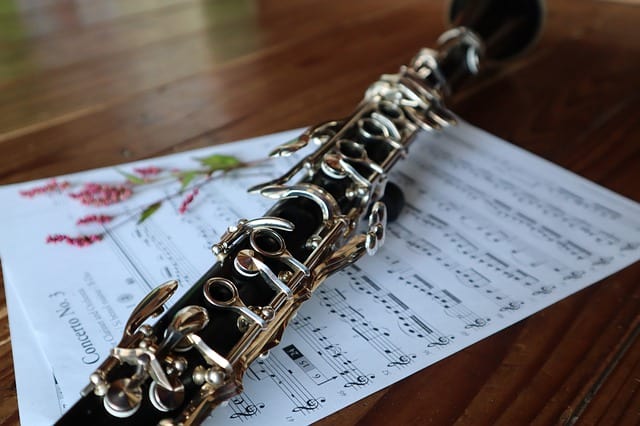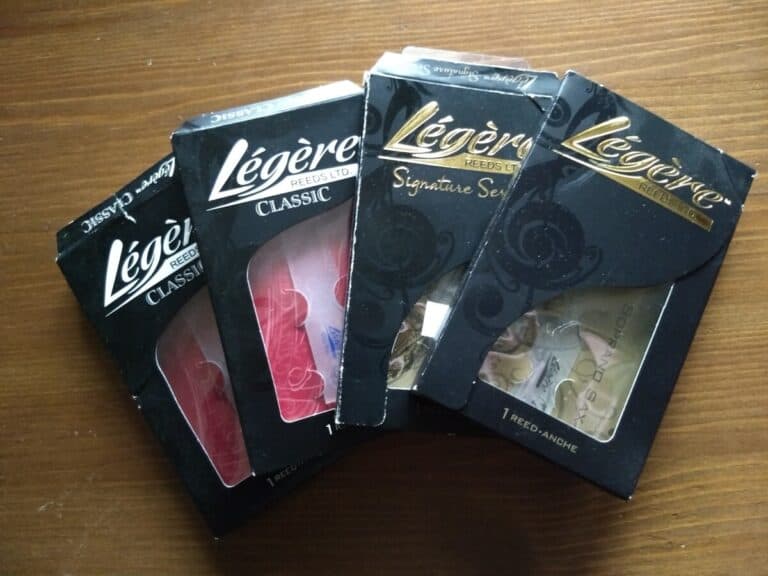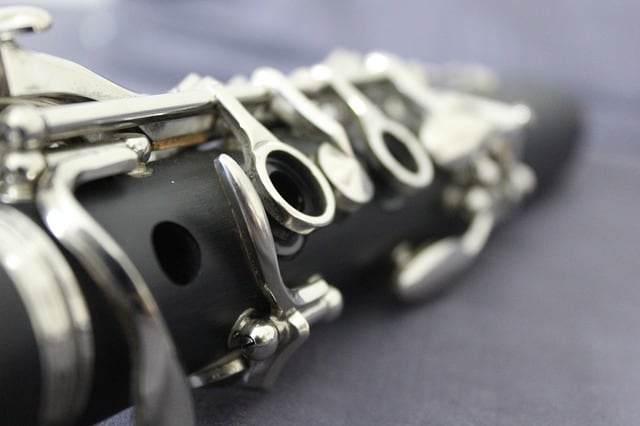What Are Clarinets Made Of?
It isn’t immediately obvious what materials the clarinet is made out of. The black color of the instrument is darker than most woods, and not typical of plastics. Nonetheless, wood and plastic are the most common materials for clarinets to be made of. In short:
Typically, high-quality clarinets are made out of wood, while lower-quality clarinets are made of plastic. However, clarinets have in the past been made out of a variety of other materials, such as metal and ivory. The most common wood to make clarinets out of is Grenadilla (also known as African Blackwood or African Hardwood). Honduran rosewood and cocobolo are used occasionally.
The goal of this article is to discuss the different materials used to make clarinets, including how common each material is in clarinets, and the pros and cons of each.
Plastic clarinets
Most beginner clarinets are made out of plastic. Out of all the materials used to make clarinets, this is the cheapest, so buying a clarinet which is made out of plastic isn’t a massive financial investment.
There are other benefits to plastic clarinets other than the fact that they’re cheap. Plastic clarinets are a little bit lighter than wooden clarinets, so children are better able to hold and play them. Additionally, plastic clarinets can reliably play outdoors, whereas wooden clarinets are greatly affected by humidity and outdoor weather.
The biggest deterrent to using plastic clarinets is that they have a reputation for being low quality. This isn’t actually due to being made of plastic; rather, many plastic clarinets are simply poorly constructed because they are intended for beginners.
That being said, plastic clarinets have gotten much better in recent years than they used to be. While they might have once been notoriously terrible, many designs are good enough that it’s possible to have a profession-quality sound while playing them.
Some of the better plastic clarinets are made out of hard rubber, a type of plastic. In fact, there are musicians who will claim that hard rubber is actually a better material to make clarinets out of than wood, despite wood being the professional standard! The Lyrique brand, owned by Tom Ridenour, is one example of a well-respected clarinet brand that uses hard rubber.
There are also plastic clarinets made out of resin, and these are typically less reputable. In theory, it might be possible to make a quality clarinet out of resin. However, those which exist are usually mass-produced, of terrible quality, and only suitable for beginners.
If you are a beginner planning on playing the clarinet, I would recommend buying a plastic model (preferably hard rubber instead of resin). They are typically less of a financial commitment than wooden clarinets, and in many cases can still sound good and last a long time.
Wooden clarinets
Grenadilla
Grenadilla (or African Blackwood) is the most common wood used to make clarinets, and it is also used in other wooden instruments such as oboes and bagpipes.
Grenadilla only grows in central and southern Africa, and is a rare and expensive (almost endangered) tree. It is much denser and more durable than most kinds of wood, and is useful in instrument manufacturing because it is less porous than most woods and unlikely to change shape even when exposed to water. In fact, it is so fine-grained and resistant to cracking that it is sometimes compared to metal.
Many musicians will claim that Grenadilla offers a better sound than other types of wood. However, this is actually not the reason that Grenadilla is used. In fact, there are woods that are thought to sound better than Grenadilla, such as Honduran Rosewood.
Rather, Grenadilla is selected almost exclusively for its qualities that make manufacturing instruments with it much easier than other types of wood. The problem with most woods is that they lack durability and are highly porous, causing them to become waterlogged and change shape. Trying to manufacture with such materials is frustrating, because it is difficult to ensure any consistency between instruments, and it is also difficult to prevent defects (such as leaks) from arising.
While it may be true that consistency and durability of the instrument are relevant concerns to the clarinetist, the fact remains that the reason they claim to prefer Grenadilla is actually quite different from the reason that they actually use it.
Grenadilla is still considered to have a reasonable quality of sound to most professional clarinetists. Arguably, however, the craftsmanship of the clarinet is more relevant to its sound than the material which it is made out of. Due to the improved quality of plastic clarinets (specifically hard rubber) in recent years, it is unclear that Grenadilla remains the better option for clarinets.
Honduran Rosewood
Unlike Grenadilla, Honduran Rosewood is known specifically for its acoustic properties. It is often used in xylophone (and marimba) keys and guitars because it has a reputation for producing a rich and resonant sound. It is somewhat less durable than Grenadilla.
Honduran Rosewood tends to be relatively expensive and rare for a wood, as was the case with Grenadilla. It has gradually become more difficult to obtain after suffering a poaching epidemic in 2011 and 2012. Nonetheless, it still remains a popular material for making clarinets.
While Honduran Rosewood is used to make clarinets that are popular and reputable, it is less common than Grenadilla for previously mentioned manufacturing reasons. Honduran Rosewood has relatively large pores, which can absorb water and ultimately cause the instrument to crack.
Furthermore, though Rosewood clarinets have a reputation for sounding fantastic, the topic of whether or not the material actually matters is hotly debated. Some will claim they notice a difference, while others will claim they notice no difference at all, or that the difference is insignificant.
Even if it turns out that Rosewood clarinets do sound better, they are known for having other problems as well. Specifically, many clarinets complain of poor intonation on Rosewood clarinets, and claim that the instrument tends to “wear out” after playing it for some time. Naturally, it is difficult to encourage investing money in an instrument that might not be able to play well in a few years.
Cocobolo
Cocobolo is an exotic wood native to Mexico which is nearly always in high demand, and thus is expensive. It is reasonably durable, but has some of the same problems that Honduran Rosewood has. For instance, it can be prone to cracking, and it is also affected more by changes in humidity than Grenadilla.
It also has a reputation for having a soft and pleasant (sometimes described as “intimate”) sound, perhaps preferable to the sound of Grenadilla clarinets. However, clarinets made of Cocobolo generally do not project as well, and may not be as suitable in circumstances where they are required to play loudly.
Perhaps the biggest issue with Cocobolo is that it is notorious for causing allergic reactions. Not everybody is allergic, but you will find it to be a major inconvenience if you are trying to play an instrument made out of Cocobolo when you have an allergy to it. The tell is if you get a rash from it. You might consider going to a music store to try a Cocobolo instrument and wait a day or two before buying it. If you get a rash, then it is probably a bad idea to purchase it.
Overall, Cocobolo is a wonderful material to make clarinets out of provided that you don’t have an allergy and are willing to take good care of it.
Other materials
Metal
Metal clarinets were much more popular in the early twentieth century than they are today. They were first intended as an alternative to wooden clarinets and caught on quickly. Unlike wooden clarinets, they were resistant to cracking and played consistently regardless of temperature or humidity (making them great for marching bands). As they were mass-produced, however, they gained a reputation for being low-quality.
There were a few metal clarinets which were of professional quality, and were often made of expensive materials with good acoustic properties such as silver. However, they never caught on because their reputation was tarnished by the cheaper and mass-produced metal clarinets.
After plastic clarinets were created, metal clarinets fell out of style. Plastic was simply cheaper, and came with all the same perks that metal clarinets came with. You may occasionally find a metal clarinet on Ebay, but seeing them in action during a performance is a rare occurrence.
Ivory
This was a popular material during the eighteenth century. It doesn’t have any particular problems acoustically-speaking, but it doesn’t keep its shape well and is ultimately difficult to manufacture with.
For the most part, the only ivory clarinets that you’ll see nowadays are antiques.







